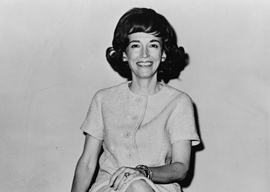
November 01, 2016

Helen Gurley Brown
Source: Wikimedia Commons
Four years after her death, Helen Gurley Brown”author of the 1962 phenomenon Sex and the Single Girl and longtime Cosmopolitan editor in chief”is having a moment.
Not one but two bulging biographies are now out (to accompany the one released just before she died). HGB obsessive Lena Dunham has optioned them, with a Mad Men-style series in mind. And the sale of Brown’s breathtaking four-story Central Park West penthouse recently made international news due to its price tag (just under $20 million); intact, explosion-on-the-set-of-Dynasty decor; and provenance: The old broad continues to fascinate, beyond the grave.
That HGB inspired a trio of books in short order prompted less successful women writers at The Nation and The New York Review of Books, respectively, to wonder why”using the same catty contempt that led Gurley Brown’s NYT obituarist to snark, “She was 90, though parts of her were considerably younger.”
Tellingly, over 300 comments posted beside that bitchy obit chastised its author and defended its subject as a publishing pioneer and even a feminist heroine, trademark fishnets and all.
While I never acquired Gurley Brown’s nigh-on industrious sexual fluency (she was a veritable Whore-atio Alger), I recognize other striving proles at a great distance, and reflexively cheer them on.
Ozark-born and acned, flat-chested and fatherless, Brown never stopped calling herself a “mouseburger” and a “hillbilly.” Ambitious individuals of limited means often use such exaggerations to spur themselves to success, the way athletes use steroids. In HGB’s case, the plain-Jane “bole” wasn”t that “hyper”: One biography is bluntly titled Not Pretty Enough; another, Enter Helen“my husband glanced at the cover and said, “No, thanks.”
Through the 1940s and “50s, the degree-free Gurley hoisted herself up a ladder of menial clerical jobs to become the highest-paid female copywriter on the West Coast.
She also slept with a still-shocking number of men (173!) but nevertheless married exceedingly well (her husband went on to produce Jaws and The Sting) and for life, at age 37.
Now: I don”t remember a time when I didn”t want to “get the hell out of my childhood,” to steal from one of Brown’s huffier analyzers. While other girls fantasized about their weddings, I obsessed over my future big-city apartment, rearranging its layout, color scheme, and furnishings in my imagination.
I also realized blessedly early that I”d never score so much as a free drink off my looks, so I cultivated a stoic work ethic. As the first person in my family to finish high school (and later, to earn a five-figure salary), I scrounged obsessively for role models among total strangers and even fictional characters.
Yet I never consciously read a word of Brown’s (and there are millions of them) until after her death. (Unavoidable at cash-register checkouts in over 100 countries, those excitable Cosmo cover cutlines don”t count: They were always written by her husband.)
It’s a testament to Brown’s cultural influence that I nevertheless absorbed her worldview: Work first, last, and forever; the Single Girl’s Apartment is her castle; don”t marry too young, if at all; career women probably shouldn”t have kids. She called one of her books Having It All, helping popularize that fatal phrase, but for the childless Helen (and me), “all” was simply synonymous with “your own way,” and if that meant no offspring, so be it.
Her body of work is really one big midcentury “conduct book“ of now-familiar and pragmatic”even “puritanical“”financial, employment, and relationship advice, not all of it silly or dated.
In fact, it’s her biographers who look out of touch when they fall over themselves to condemn Gurley Brown’s accurate-after-all insistence that white Western women didn”t have to worry about AIDS.